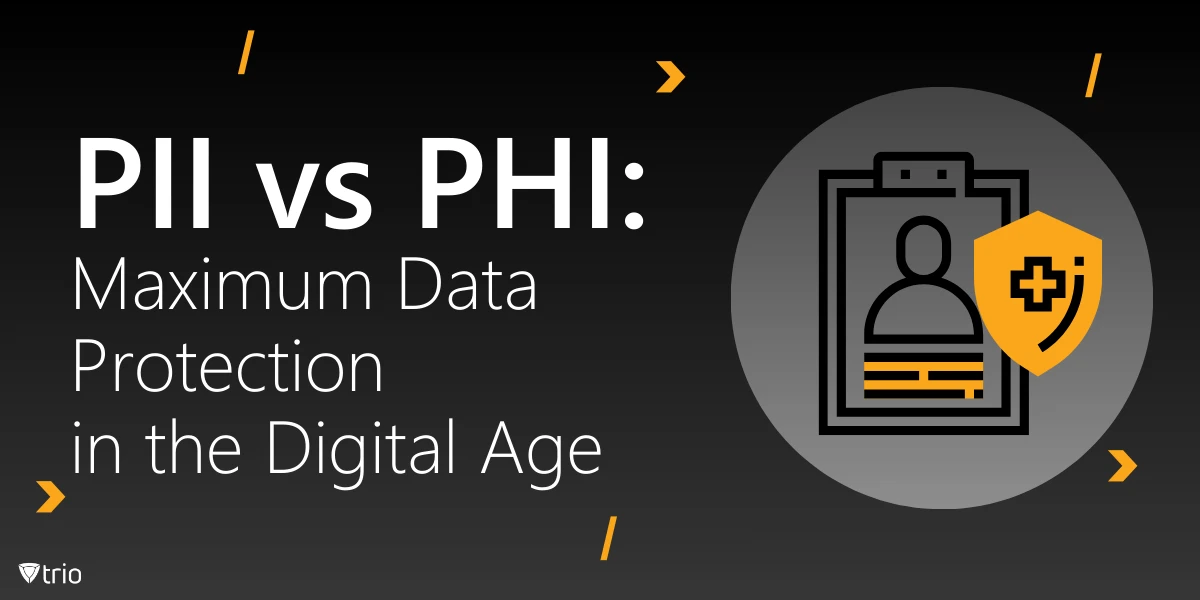Data protection has become a critical concern for individuals and organizations alike. Two terms that often come up in discussions about data privacy are PII (Personally Identifiable Information) and PHI (Protected Health Information). While these terms are related, they have distinct meanings and implications. This blog post will delve into the key differences between PII vs PHI, providing examples and exploring the rules that govern their protection.
PII vs PHI: Definitions and Scope
Understanding the definitions and scope of PII and PHI is crucial for anyone dealing with personal data or working in fields related to data privacy and protection. These two categories of information, while often overlapping, have distinct characteristics and are subject to different regulations. Let’s explore each of them in detail to grasp their unique attributes and the contexts in which they are most relevant.
PII (Personally Identifiable Information)
PII refers to any information that can be used to identify a specific individual. This can include:
- Full name
- Social Security number
- Driver’s license number
- Bank account information
- Email address
- Biometric data
PII is a broad category that encompasses various types of personal data, regardless of the context in which it is used.
PHI (Protected Health Information)
PHI, on the other hand, is a subset of personal information specifically related to health data. It includes any information about health status, provision of health care, or payment for health care that can be linked to a specific individual. PHI is protected under the Health Insurance Portability and Accountability Act (HIPAA) in the United States.
PHI vs PII Examples
To better understand the difference between PHI and PII, let’s look at some examples:
PII Examples:
- Name and address
- Date of birth
- Telephone number
- Credit card number
- Passport number
- IP address (in some cases)
PHI Examples:
- Medical records
- Lab test results
- Hospital bills
- Health insurance information
- Prescription information
- Any health information combined with patient identifiers
It’s important to note that some information can be both PII and PHI, depending on the context. For instance, a person’s name alone is PII, but when combined with their medical condition, it becomes PHI.
PII vs PHI Data: Key Differences
While there is some overlap between PII and PHI, there are several key differences:
Scope: PII is a broader category that includes any information that can identify an individual, while PHI is specifically related to health information.
Regulatory Framework: PHI is governed by HIPAA regulations, which provide strict guidelines for its handling and protection. PII, while protected by various laws, doesn’t have a single overarching regulatory framework in the United States.
Covered Entities: HIPAA rules for PHI apply specifically to healthcare providers, health plans, and healthcare clearinghouses. PII protection laws often apply more broadly to various organizations that handle personal data.
Consent Requirements: The use and disclosure of PHI typically require explicit patient consent, whereas the rules for PII usage can vary depending on the type of information and the context of its use.
Penalties for Violations: Violations involving PHI can result in severe penalties under HIPAA, including hefty fines and potential criminal charges. Penalties for PII breaches can vary depending on the applicable laws and the nature of the violation.

PHI vs PII Definition: A Closer Look
To further clarify the PHI vs PII definition, let’s break it down:
- PII Definition: Any information that can be used to distinguish or trace an individual’s identity, either alone or when combined with other personal or identifying information that is linked or linkable to a specific individual.
- PHI Definition: Any information in a medical record that can be used to identify an individual, and that was created, used, or disclosed in the course of providing a health care service, such as a diagnosis or treatment.
PII vs PHI Rules: Compliance and Best Practices
When it comes to PII vs PHI rules, organizations must be aware of the different requirements for each:
PII Protection Rules:
- Implement reasonable security measures to protect PII from unauthorized access, destruction, use, modification, or disclosure.
- Provide notice to individuals about your information practices and their rights.
- Obtain consent when necessary before collecting, using, or disclosing PII.
- Allow individuals to access and correct their PII.
- Ensure data minimization by collecting only necessary information.
PHI Protection Rules (HIPAA):
- Implement physical, technical, and administrative safeguards to protect PHI.
- Conduct regular risk assessments.
- Develop and implement policies and procedures for PHI handling.
- Train employees on HIPAA compliance.
- Appoint a HIPAA Privacy Officer and Security Officer.
- Obtain business associate agreements with vendors who handle PHI.
- Provide patients with a Notice of Privacy Practices.
Trio: Enhancing PII and PHI Protection with Mobile Device Management
In the complex landscape of data protection, organizations need robust solutions to safeguard both PII and PHI, especially in today’s mobile-first world. This is where Trio’s mobile device management solution comes into play, offering a comprehensive approach to securing sensitive information on mobile devices.
Trio understands the nuances between PII vs PHI data and provides tailored features to address the unique challenges of protecting both types of information:
- Advanced Encryption: Trio ensures that all data, whether PII or PHI, is encrypted on mobile devices, protecting it from unauthorized access even if a device is lost or stolen.
- Granular Access Controls: With Trio, organizations can implement fine-grained access controls, ensuring that only authorized personnel can access specific types of sensitive information, whether it’s PII or PHI.
- Remote Wipe Capabilities: In case of a security breach or lost device, Trio allows organizations to remotely wipe all data, including PII and PHI, preventing potential data leaks.
- Compliance Management: Trio helps organizations maintain compliance with various regulations governing PII and PHI, including HIPAA, by providing detailed audit logs and reporting features.
- Secure Communication Channels: Trio offers secure messaging and file-sharing capabilities, ensuring that any transmission of PII or PHI is protected from interception.
By implementing Trio’s mobile device management solution, your organization can significantly enhance its data protection strategies, ensuring the safety of both PII and PHI in an increasingly mobile work environment.
We invite you to experience the power of Trio in protecting your sensitive data. Try our free demo today and see how Trio can revolutionize your approach to mobile data security, whether you’re dealing with PII, PHI, or both.
PII vs PHI: Conclusion
Understanding the differences between PII and PHI is crucial for organizations handling sensitive data. While both types of information require protection, PHI is subject to more stringent regulations due to its sensitive nature and the potential impact on individuals’ healthcare and privacy.
See Trio in Action: Get Your Free Trial Now!
By recognizing the nuances between pii vs phi data and adhering to the respective rules and best practices, organizations can better protect individuals’ privacy, maintain compliance, and build trust with their customers and patients.
Remember, whether you’re dealing with PII or PHI, the goal is the same: to safeguard individuals’ personal information and respect their privacy rights in an increasingly data-driven world.




